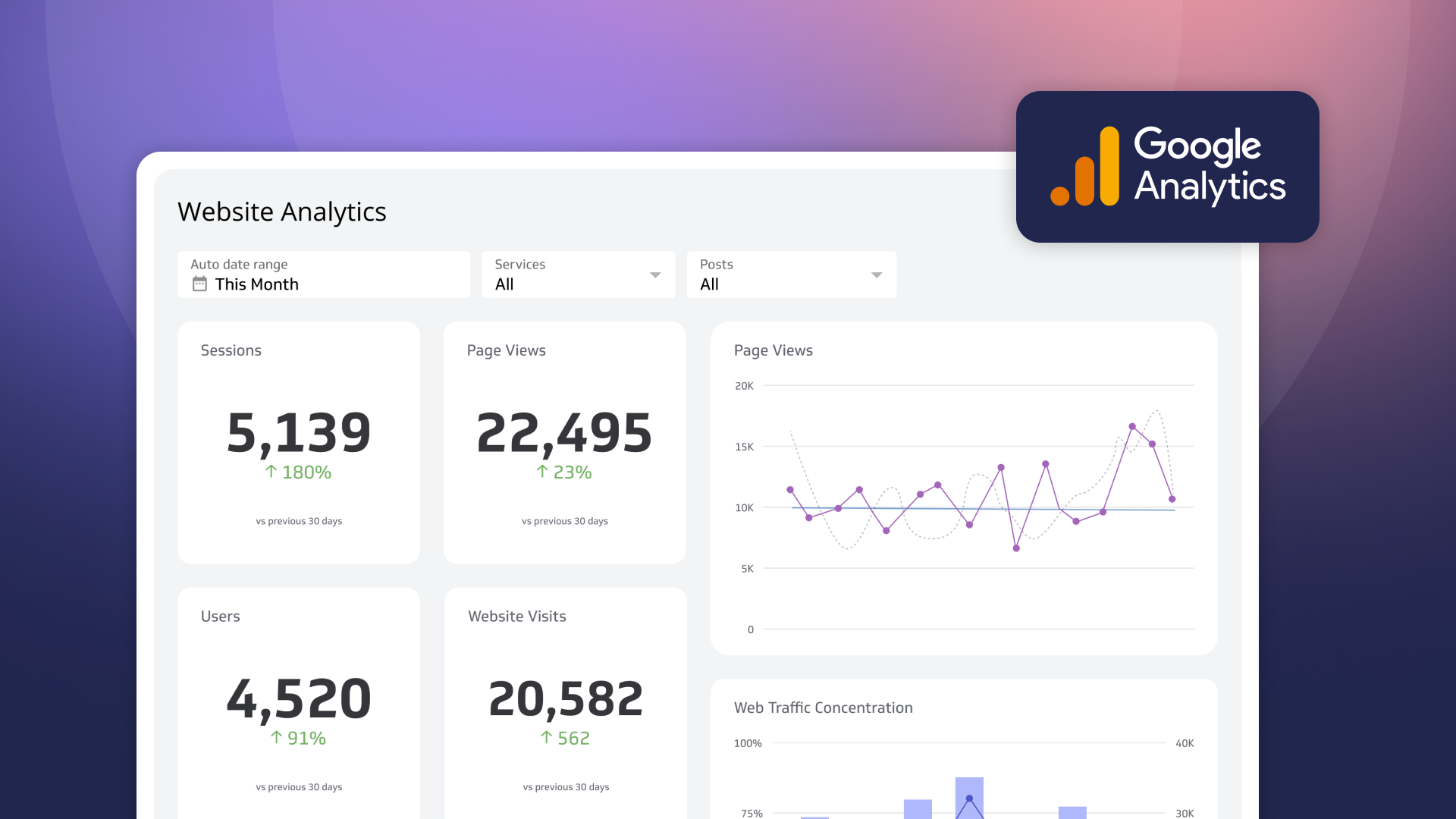How to set actionable KPI targets

Published 2024-04-09
Summary - Your KPIs (key performance indicators) mean very little unless you've paired them with actionable KPI targets. Here's how to do it.
A well-defined KPI acts like a guidepost. As you travel the winding roads of your business’s growth, your KPIs will help you navigate crossroads and keep you on the path to success.
Sadly, this isn’t the road most traveled. Many KPIs fail because they lack a proper definition, an internal champion, or, as I’ll discuss here, actionable targets.
Your KPIs should never be seen as a single guidepost. If you were on a big road trip, you’d check your map every few hours to make sure you’re on the right path. Likewise, with KPIs, the frequency of review often illuminates new and possibly more efficient paths to the same destination.
KPI targets are the guideposts (plural) your team should use to stay on track. Let’s talk more about that.
Why KPI targets matter
KPI targets do more than just outline expectations; they synchronize individual and team efforts with the broader company goals. By defining KPI targets, you effectively communicate what success looks like in specific, measurable terms, making sure everyone is going in the same direction.
Although success can sometimes feel like a nebulous concept, KPI targets bring clarity by defining it in clear, measurable terms. Whether it's increasing sales by 10%, improving customer satisfaction scores, or reducing operational costs, KPI targets spell out exactly what you aim to achieve.
Moreover, when you set KPIs, you encourage decisions based on data rather than intuition. By analyzing performance data against your targets, you can make informed choices about where to allocate resources, when to adjust strategies, and how to drive continuous improvement across your organization.
How to set actionable KPI targets
The operative word here is “actionable.” Establish actionable KPI targets that are tangible and immediately relevant. Aim too high with your targets, and you risk deflating your team before you start; aim at a target that doesn’t exist today, and you’ve created noise without any signal.
Here’s a process for setting actionable KPI targets:
Define your business objectives
Analyze your current performance
Set targets for the short and long-term
Review indicators and targets with your team
Check progress and adjust
Step 1: Define your business objectives
A KPI is a metric with a target that is core to your business’s performance. Every business has objectives, which are typically goals in regard to revenue, customer success, marketing mindshare, and productivity.
I suggest making a pit stop and learning a bit more about how to define your KPIs.
Now, I believe that most of us aren’t C-level executives plotting the big strategic moves for our business. My role, and yours, is likely more operational. We work for a specific department, be it sales, marketing, finance, or customer success.
This means our goal is to reverse engineer the big strategic move and understand how our department plays a role in achieving that business objective.
As a customer support leader, you may not be able to impact annual revenue targets directly. However, you can focus on maintaining a healthy, happy customer base by hitting your support team’s Service-Level Agreements (SLAs).
I believe that one of the biggest failings in defining KPIs is ignoring the human element. We naturally assume data speaks for itself, but it’s merely the messenger. Do yourself a favor: check your assumptions with stakeholders, particularly department heads and managers.
Step 2: Analyze your current performance
You can’t get from point A to point B without understanding point A, your starting point. The best way to set KPIs is to dig into the data, allow yourself time for discovery, and provide an honest reckoning of your performance using a tool like PowerMetrics. This will give you the basis for setting your KPI targets.
At all costs, avoid qualifying your numbers. Be honest with yourself and your team. I know it seems like rudimentary advice, but it’s surprisingly easy (and natural) to feel like your numbers are inferior.
Hey, we wouldn’t need to set KPI targets if you were exceeding all your goals. You’d be on vacation or celebrating with your team, no?
By evaluating your current performance, you get a dose of reality. Nothing kills KPIs or motivation like impossible stretch goals. Doubling your numbers sounds great, but is it realistic next month? Maybe, maybe not. This is a common challenge when setting targets for sales KPI.
Step 3: Set targets for the short and long-term
You’ve interrogated the data and now know the truth behind your numbers. It’s time to start plotting your way forward. I would start by setting a long-term KPI target. This gives an overall vision of your strategy and a goal from which to work backward.
So, let’s say your long-term marketing KPI target is 2500 monthly MQLs, and you aim to achieve that by Q1 2018. Great. That’s specific, time-bound, and relevant.
More MQLs = more revenue, which is good for business.
From here, you can start to figure out short-term KPI targets. Based on your data analysis, let’s say you currently generate 1500 MQLs a month.
You have six months to achieve your target. That means you need to figure out how to generate an additional 166 MQLs each month.
Right away, you’ll have a sense of whether this is possible or not. By setting a short-term goal to increase your monthly MQLs, you can start to work your way to achieving a big KPI target.
The real benefit of setting short-term KPI targets is that they give you almost immediate feedback on your processes and ability to execute them. Unachievable objectives deflate teams and drain morale. KPI targets must motivate and reward hard work.
So let’s say that you set out to generate an additional target of 166 MQLs in July but come up short, only generating 100. It doesn’t mean you should scrap your long-term objective, though it is cause for discussion.
As a general rule, I reevaluate long-term targets if I miss three months or one quarter’s worth of short-term KPI targets.
Step 4: Review indicators and targets with your team
Take your KPI targets to your team and review them in an open, honest environment.
For example, with a KPI presentation. Encourage feedback and act on it. If you’re a sales director, and your frontline team is telling you that there’s no way they can hit your new targets, then you must listen to them.
Does that mean acquiescence? Not necessarily. KPI targets ought to be challenging, and, as a wise executive once told me, they ought to make you a bit uncomfortable.
We aspire to achieve KPI targets because we want to push ourselves to do better and improve. If the targets you’ve suggested instantly deflate your team, identify the root causes.
Are they feeling a crunch because you’re using an outdated CRM? Or maybe you need better Salesforce dashboards? Are they lacking visibility into the processes that influence positive outcomes?
The journey towards achieving KPI targets will have you innovating and auditing current processes. You can be firm on your targets yet still empathize with the challenges in execution. As a manager, your job is to remove obstacles.
Step 5: Check your progress and adjust
The business world would be much simpler if you could just set KPI targets and magically achieve them—but it’s not. Business is complex, and growth is challenging.
You need to evaluate your KPI performance at regular intervals continually. The monthly reporting cadence is natural and an ideal starting point. It allows time for your projects to take hold and influence your numbers.
Never skip regular reviews of your KPIs. After all, these meetings serve two purposes:
First, they can provide an opportunity to celebrate success. Momentum is a worthy objective in and of itself, and positivity breeds success.
Second, they provide a forum to discuss the projects behind the numbers and evaluate how they contribute to the bottom line.
By creating an open dialogue, you can foster independence and leadership within your team and ensure every KPI you define has a champion.
Sometimes, you’ll need to make a hard decision, like adjusting your targets. In my experience, communicating a missed target can, well, suck. But it’s not the end of the world.
Show your team that you’re on top of your numbers, aware of the challenges in achieving the KPI target, and have a plan for how to solve complex problems.
No one ever got a raise for hiding from their performance. The reverse may be true: being open and forthcoming about performance can give you an opportunity to pitch solutions and contribute.
Common KPI target setting pitfalls to avoid
From the allure of vanity metrics to the perils of overambition, understanding what mistakes to avoid is as crucial as knowing what to aim for. Common pitfalls can not only derail your progress but also demotivate your team and skew your strategic focus.
Tracking too many KPIs
Setting too many KPIs can dilute focus and make it hard for your team to prioritize. Imagine trying to juggle too many balls at once—eventually, you're going to drop one.
To avoid this, carefully select a handful of KPIs that truly reflect your core goals. This focus helps ensure efforts are concentrated on the areas that matter most.
Focusing on vanity metrics
Vanity metrics might look impressive on paper, but they don't offer real value to your goals or help in making strategic decisions. These are metrics like page views or social media followers, which, without context, don't necessarily drive forward your business objectives.
Focus instead on KPIs that directly relate to your business outcomes, such as conversion rates or customer retention.
Setting unrealistic targets
Ambition is good and all, but when it comes to setting KPI targets, it’s best to be practical. Unrealistic targets can demotivate your team and set you up for failure.
Use historical data and industry benchmarks to set achievable yet challenging targets. This approach ensures goals are within reach, keeping your team motivated and on track.
Not having a clear action plan
For a KPI to be effective, there must be a defined way to influence its outcome. Make sure each KPI has associated actions or steps that can directly impact its performance. This clarity transforms your KPIs from mere measurements into tools for strategic action.
Selecting KPIs without consulting others
KPI setting shouldn't be a solo endeavor. Collaborate with team members across different departments to gain diverse insights and ensure the KPIs chosen are meaningful across the board. This collaboration fosters a sense of ownership and accountability towards meeting these targets.
Exceeding your KPI targets
Exceeding KPI targets involves going beyond the set goals and continuously improving your performance. Start by deeply understanding the KPIs and what drives them. Then, engage your team in setting these targets and brainstorm ways to enhance processes, efficiency, or productivity.
Monitor your progress and adjust strategies as needed, too. Make sure to encourage open communication within your team to share insights and challenges.
Moreover, consider investing in training or resources that could remove barriers to success. Always look for innovative solutions and stay adaptable to changes in your industry or market conditions. Celebrating small wins along the way can motivate your team to exceed their KPI targets.
Conclusion
Setting the right KPI targets guides your team towards achieving business goals. It's about being clear and realistic with what you aim to accomplish.
As you define these targets, your team will get a concrete idea of what success looks like for your organization and can work together to get there.
FAQs
How do you create a target KPI?
To create a target key performance indicator (KPI), start by defining the factors you need to monitor for your company's success. Identify the main goals your company wants to achieve, whether it's increasing sales, improving customer satisfaction, or boosting productivity.
Once you've determined these goals, set clear, measurable targets for each KPI. For example, if your goal is to increase sales, a KPI target might be to grow sales by 10% in the next quarter.
Make sure these targets are achievable and relevant to your business objectives. Then, collect the necessary data to track these KPIs and review them regularly to ensure you're on track to meet your targets.
What is a target estimate for KPI?
A target estimate for a KPI is a specific, quantifiable goal set for a key performance indicator. It's like a milestone that you aim to reach within a set period. This estimate is based on analyzing past performance data and understanding your company's capacity for improvement.
For instance, if your customer service team currently handles 100 calls per day, a target estimate might be to increase this to 120 calls per day. The key is to make these estimates realistic and aligned with your overall business goals, ensuring they push your team to improve without being unattainable.
Related Articles

How to Build Google Analytics 4 Dashboards in Klips
By Jonathan Taylor — June 6th, 2023
How to use the Google Analytics 4 Query Explorer to export data
By Jonathan Taylor — June 1st, 2023
Unlock Data-Driven Decisions with ChatGPT & MetricHQ
By Nicolas Venne — April 3rd, 2023

